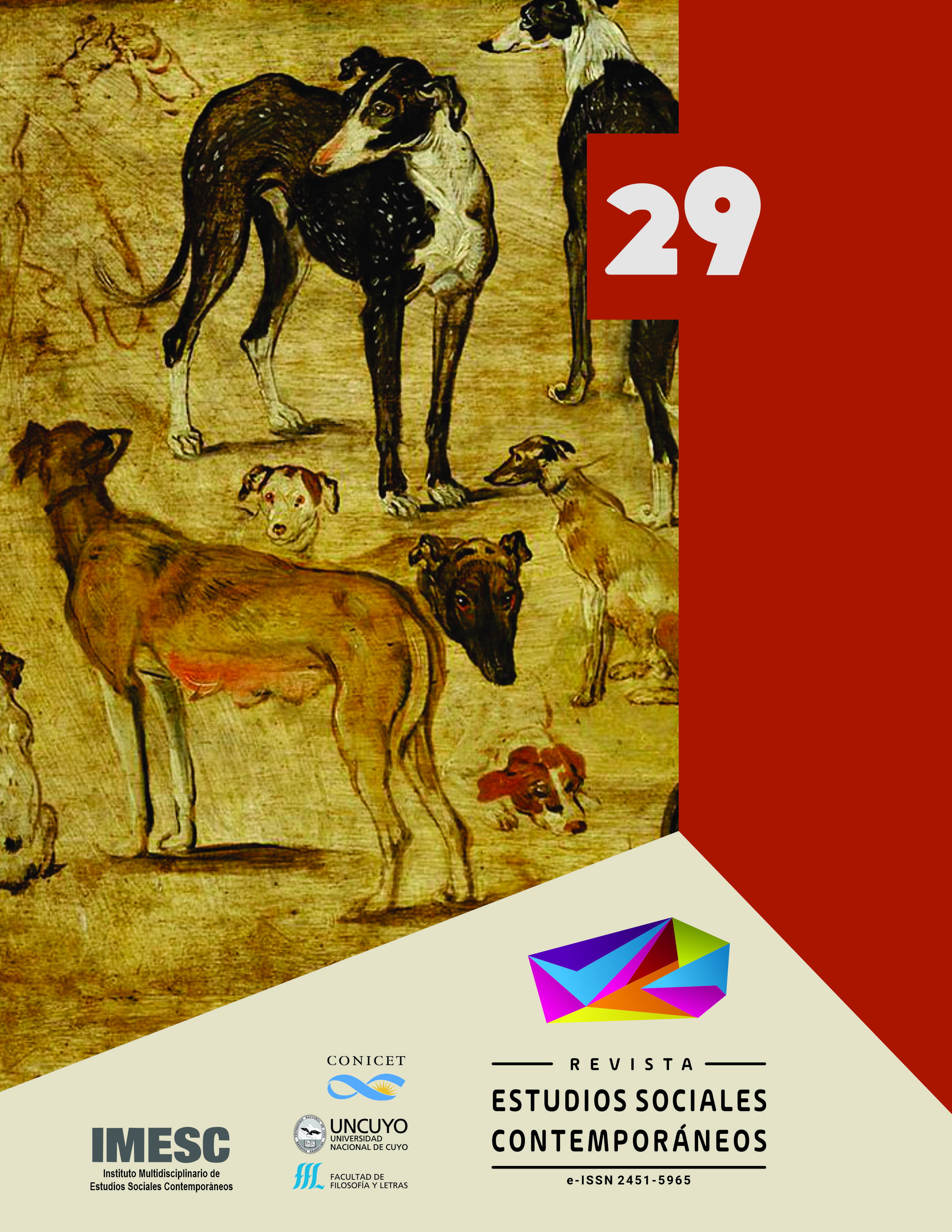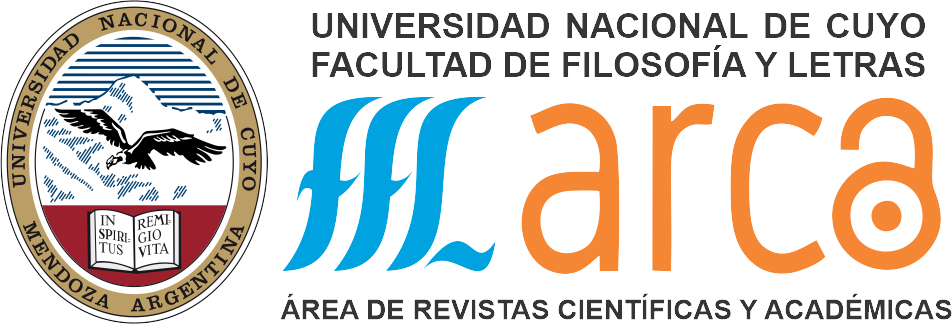“Una manera de observar”. Aportes de los Estudios Humano-Animales para repensar los conflictos con fauna
DOI:
https://doi.org/10.48162/rev.48.055Palavras-chave:
Estudios Humano-Animales, Conflictos con fauna silvestre, Animales silvestres, Sociedad/NaturalezaResumo
El objetivo de este artículo es reflexionar sobre los conflictos con fauna silvestre desde la perspectiva de los Estudios Humano-Animales (EHA). Se trata de una propuesta de orden exclusivamente teórico, en función de lo cual la metodología comprende la lectura detallada y el análisis de distintos grupos de antecedentes bibliográficos. Los resultados indican que las relaciones entre humanos y animales silvestres no constituyen, hasta el momento, un tópico de interés destacado en los EHA. Por su parte, en el estudio de los conflictos con fauna silvestre, si bien se han ido incorporando aspectos de sus dimensiones humanas, persiste, en general, una mirada sobre el animal reducida a sus aspectos biológicos o instintivos. En este sentido, los EHA ofrecen un marco de análisis diferente que permite complejizar esa definición unívoca, en función de que, de un lado, se privilegia la indagación sobre los vínculos humano-animales, y del otro, se concibe a los animales como seres sintientes y como una parte activa de dichos vínculos.
Referências
BIRKE, L. and HOCKENHULL, J. (2012a). Introduction: On Investigating Human-Animal Relationship. En L. a. Birke, Crossing Boundaries. Investigating Human-Animal Relationship (págs. 1-14). Boston: Brill.
BIRKE, L. and HOCKENHULL, J. (2012b). Investigating Human-Animal Bonds: Realities, Relatings, Research. En L. a. Birke, Crossing Boundaries. Investigating Human-Animal Relationship (págs. 15-36). Boston: Brill.
BULLER, H. (2004). Where the wild things are: the evolving iconography of rural fauna. Journal of Rural Studies, 131-141.
CARUSO, N.; LUENGOS VIDAL, E.; LUCHERINI, M.; GUERISOLI, M.; MARTÍNEZ, S. y CASENAVE, E. (2017). Carnívoros en el sudoeste de la provincia de Buenos Aires: ecología y conflictos con los ganaderos. Revista de Investigaciones Agropecuarias, 1-10.
CRONON, W. (1995). The Trouble with Wilderness; or Getting Back to th Wrong Nature. En W. E. Cronon, Uncommon Ground: Rethinking the Human Place in Nature (págs. 69-90). New York: W.W. Norton.
DAVEY, G. (2007). Visitors' Effects on the Welfare of Animals in the Zoo: A Review. Journal of Applied Animal Welfare Science , 169-183.
DE CÓZAR ESCALANTE, J. (2014). ¿Una cosmopolítica de lo salvaje?: la composición técnica del mundo natural. Pléyade, 97-118.
DECKER, D. and CHASE, L. (1997). Human dimension of living with wildlife. A management challenge for the 21st century. Wildlife Society Bulletin , 25(4) 788-795.
DEMELLO, M. (2012). Animals and Society. An introduction to Human-Animal Studies. New York: Columbia University Press.
DESPRET, V. (2022). Habitar como un pájaro. Modos de hacer y de pensar los territorios. . Buenos Aires: Cactus.
DICKMAN, A. J. (2010). Complexities of conflict: the importance of considering social factors for effectively resolving human-wildlife conflict. Animal Conservation, vol. 13, 458-466.
ENCK, J. and DECKER, D. (1997). Examining assumptions in wildlife management: A contribution of human dimensions inquiry. Human Dimensions of Wildlife: An International Journal, 2:3, 56-72.
GÁSPERO, P.; EASDALE, M.; PEREIRA, J.; FERNÁNDEZ-ARHEX, V.; VON THÜGEN, J. (2018). Human-carnivore interaction in a context of socio-productive crisis: Assesing smallholder strategies for reducing predation in North-West Patagonia, Argentina. Journal of Arid Environments, 92-98.
HILL, C. (2017). Introduction. Complex Problems. Using a Biosocial Approach to Understanding Human-Wildlife Interactions. En C. Hill, & A. a. Weber, Understanding Conflicts about Wildlife. A Biosocial Approach (págs. 1-14). New York: Berghahn.
KNIGHT, J. (2009). Introduction. En J. K. Editor, Natural Enemies. People-wildlife conflicts in anthropological perspective (págs. 1-17). New York: Routledge.
MANFREDO, M. (2008). Who cares about wildlife? Social Science Concepts for Exploring Human-Wildlife Relationships and Conservation Issues. New York: Springer.
MEKONEN, S. (2020). Coexistence between human and wildlife: the nature, causes and mitigations of human wildlife confict around Bale Mountains National Park, Southeast Ethiopia. BMC Ecology, 1-9.
MICHALON, J. (2020). Causa animal y ciencias sociales. ¿Del antropocentrismo al zoocentrismo? Nueva Sociedad, 116-126.
NOCELLA II, A.; SORENSON, J.; SOCHA, K.; MATSUOKA, A. (2014). The Emergence of Critical Animal Studies: The Rise of Intersectional Animal Liberation. En J. S. Anthony J. Nocella II, DEFINING Critical Animal Studies: An Intersectional Social Justice Approach for Liberation (págs. xix-xxxvi). NEw York: Peter Lang Publishing.
NOVARO, A.; GONZÁLEZ, A.; PAILACURA, O.; BOLGERI, M.; HERTEL, M.; FUNES, M.; WALKER, R. (2017). Manejo del conflicto entre carnívoros y ganaderia en Patagonia utilizando perros mestizos protectores de ganado. Mastozoología Neotropical, 24 (1):47-58.
O´CONNOR, J. (2011). Causas Naturales. Ensayos de marxismo ecológico. México Distrito Federal :Siglo XXI.
SHAPIRO, K. (2020). Human-Animal Studies: Remembering the Past, Celebrating the Present, Troubling the Future. Animals and Society, 797-833.
SHERWEN, S.; HEMSWORTH, P. (2019). The Visitor Effect on Zoo Animals: Implications and Opportunities for Zoo Animal Welfare. Animals, 1-27.
TREVES, A. and ULLAS KARANTH, K. (2003). Human-Carnivore Conflict and Perspectives on Carnivores Management Worldwide. Conservation Biology, Vol. 17, Nº6, 1491-1499.
TREVES, A.; WALLACE, R.; NAUGHTON-TREVES, L.; MORALES, A. (2006). Co-Managing Human-Wildlife Conflicts: A Review. Human Dimension of Wildlife, Vol. 11, 383-396.
Downloads
Publicado
Como Citar
Edição
Seção
Licença
Copyright (c) 2023 María Paula D’Amico

Este trabalho está licenciado sob uma licença Creative Commons Attribution-NonCommercial 4.0 International License.
























